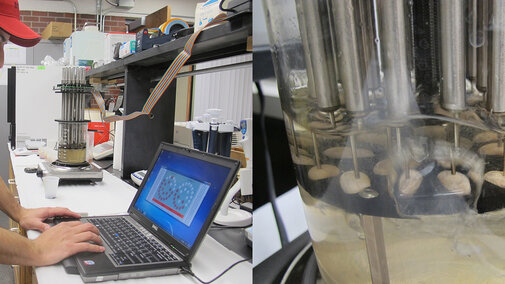The dry edible bean breeding program at the University of Nebraska-Lincoln is focused on developing new lines of dry beans that have high yield performance, multiple disease resistance, tolerance to heat and drought, and other preferred traits.
For example, seed size and quality are important, as are plants that stand upright, which are more suited to direct harvest, a one-step process favored by a growing number of farmers, where the combine is the first and only pass through the field. Another trait that’s important is cooking time.
Disease resistance, drought tolerance, and plant architecture can be observed in the field. But measuring cooking time is a chore for the laboratory. Comparing the cooking time of hundreds of breeding lines of dry beans can occupy weeks of lab time.
At UNL’s Panhandle Research and Extension Center in Scottsbluff, that job falls to Eduardo Cruzado, research technician for Carlos Urrea, the UNL dry bean breeding specialist based at the Panhandle Center.
“At the beginning of every year I conduct cooking tests on beans from different projects that the principal investigator selects, and I start cooking the beans to check the cooking times and the seed quality of each one, Cruzado said. “The reason is that we are developing beans that cook fast. Consumers prefer beans that cook in 30 or 45 minutes to beans that take two to three hours.”
The cooking tests take weeks, depending on how many bean samples need to be tested. Normally Cruzado spends about a month of lab time cooking beans and recording data for each variety.
Testing the cooking time of a bunch of dry bean samples has been made easier and more accurate by an automated cooker purchased with grants from the Nebraska Dry Bean Commission and the university's Agricultural Research Division in the Institute of Agriculture and Natural Resources.
The automated Mattson Cooker can cook 16 samples a day. The previous Mattson cooker, which had to be operated manually, would cook about 12 samples a day.
The Mattson cooker is widely used to measure relative cooking times on all pulse crops or legumes including lentils, peas, chickpeas, and dry beans. Cooking time is important to consumers, but the data is also useful to crop breeders, food processors, and dry bean importers and exporters as an indicator of seed quality.
The original version was developed in the 1940s. The automated model, developed by the Canadian Grain Commission's Pulse Research team, produces accurate data, but does not require uninterrupted attention by the technician.
The new cooker, acquired from Michigan State University, also records cooking time of all 25 beans in each batch automatically and records the data to a laptop computer.
An Inside Look at the Process
Cooking beans and measuring the results is a meticulous process. The beans to be tested are selected from 100-seed samples from each variety plot. The best looking 50 beans are weighed dry, soaked for 16 hours in distilled water, and weighed again to see how much water they absorbed. Beans that cracked or haven’t absorbed water are set aside, and then 25 beans are placed in the cooker.
The Mattson cooker itself consists of a pad, several inches in diameter, with 25 shallow depressions (“saddles”) that hold one bean apiece. The pad rests on feet that hold it up off the bottom surface of the cooking pan. A framework expending upwards from the circular pad supports 25 metal plungers, each slightly more than 1 foot in length and about 1/ 2 inch in diameter.
Each plunger is tipped by a finer probe (about the size of a small nail). Each plunger tip rests on one of the 25 beans, and the beans are considered cooked when they are tender enough to be pierced by the tip of the plunger.
The automated Mattson cooker has a circuitry board near the top of the plungers with an individual switch on each plunger to record when each one drops. After the beans are placed into the cooker, the entire assembly is lowered into a beaker full of boiling water. The computer is given a command to start the test. After 80% of the plungers have pierced the beans, the trial is halted and the times are recorded in the computer. On the sample Cruzado is cooking this day, it takes 49 minutes before the computer signals that 80% percent of the plungers have fallen. The 25 beans range from raw to cooked to overcooked. With the data recorded, the process begins again with another batch.

